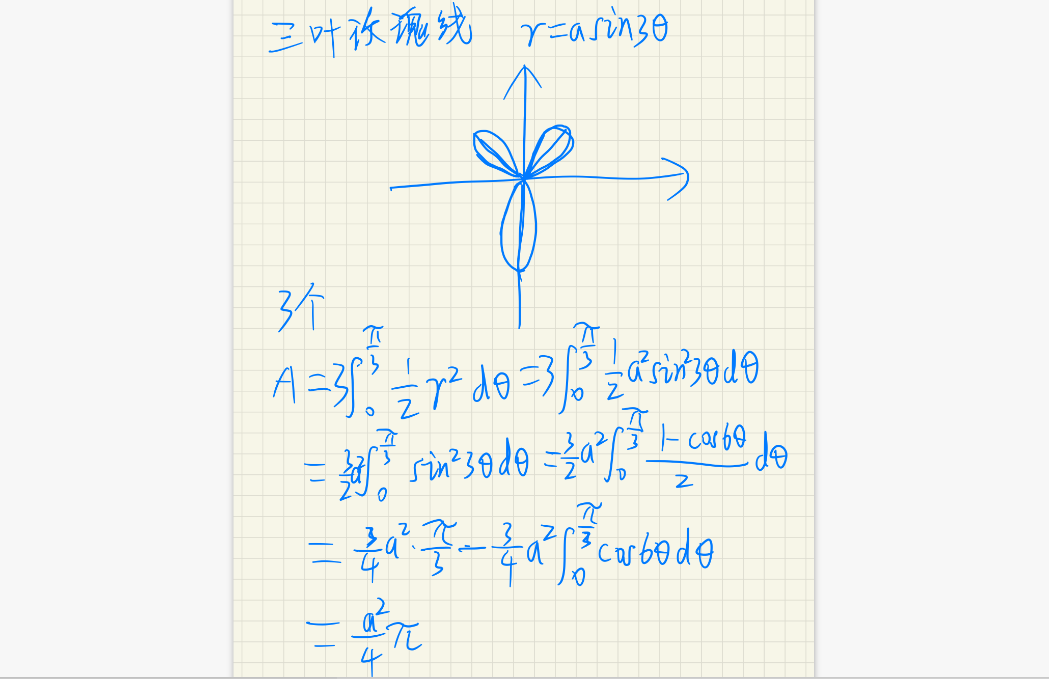先介绍一下茹茹心形线:
x 2 + y 2 − ∣ x ∣ y = 1 x^2+y^2-|x|y=1 x2+y2−∣x∣y=1

化为参数方程:
第一步,化为极坐标方程:
r 2 − ∣ r cos θ ∣ r sin θ = 1 r 2 ( 1 − ∣ cos θ ∣ sin θ ) = 1 r = ρ ( θ ) = 1 1 − ∣ cos θ ∣ sin θ r^2-|r\cos\theta|r\sin\theta=1\\ r^2(1-|\cos\theta|\sin\theta)=1\\ r=\rho(\theta)=\frac{1}{\sqrt{1-|\cos\theta|\sin\theta}} r2−∣rcosθ∣rsinθ=1r2(1−∣cosθ∣sinθ)=1r=ρ(θ)=1−∣cosθ∣sinθ1

第二步化为参数方程:
{ x = r cos θ = cos θ 1 − ∣ cos θ ∣ sin θ y = r sin θ = sin θ 1 − ∣ cos θ ∣ sin θ \begin{cases} x=r\cos\theta=\frac{\cos\theta}{\sqrt{1-|\cos\theta|\sin\theta}}\\ y=r\sin\theta=\frac{\sin\theta}{\sqrt{1-|\cos\theta|\sin\theta}}\\ \end{cases} ⎩ ⎨ ⎧x=rcosθ=1−∣cosθ∣sinθcosθy=rsinθ=1−∣cosθ∣sinθsinθ
这种方程写出来有一种凑参数方程的感觉,不如用万能公式把三角函数去掉。
先科普一波万能公式:
sin α = 2 tan α 2 1 + tan 2 α 2 cos α = 1 − tan 2 α 2 1 + tan 2 α 2 tan α = 2 tan α 2 1 − tan 2 α 2 \sin \alpha=\frac{2\tan\frac{\alpha}{2}}{1+\tan^2\frac{\alpha}{2}}\\ \cos \alpha=\frac{1-\tan^2\frac{\alpha}{2}}{1+\tan^2\frac{\alpha}{2}}\\ \tan \alpha=\frac{2\tan\frac{\alpha}{2}}{1-\tan^2\frac{\alpha}{2}} sinα=1+tan22α2tan2αcosα=1+tan22α1−tan22αtanα=1−tan22α2tan2α
所以有
x = cos θ 1 − ∣ cos θ ∣ sin θ = 1 − tan 2 θ 2 1 + tan 2 θ 2 1 − ∣ 1 − tan 2 θ 2 1 + tan 2 θ 2 ∣ 2 tan θ 2 1 + tan 2 θ 2 = 1 − tan 2 θ 2 ( 1 + tan 2 θ 2 ) 2 − 2 ∣ 1 − tan 2 θ 2 ∣ tan θ 2 y = sin θ 1 − ∣ cos θ ∣ sin θ = 2 tan θ 2 ( 1 + tan 2 θ 2 ) 2 − 2 ∣ 1 − tan 2 θ 2 ∣ tan θ 2 \begin{aligned} x&=\frac{\cos\theta}{\sqrt{1-|\cos\theta|\sin\theta}}\\ &=\frac{\frac{1-\tan^2\frac{\theta}{2}}{1+\tan^2\frac{\theta}{2}}}{\sqrt{1-\left|\frac{1-\tan^2\frac{\theta}{2}}{1+\tan^2\frac{\theta}{2}}\right|\frac{2\tan\frac{\theta}{2}}{1+\tan^2\frac{\theta}{2}}}}\\ &=\frac{1-\tan^2\frac{\theta}{2}}{\sqrt{\left(1+\tan^2\frac{\theta}{2}\right)^2-2\left|1-\tan^2\frac{\theta}{2}\right|\tan\frac{\theta}{2}}}\\\\\ y&=\frac{\sin\theta}{\sqrt{1-|\cos\theta|\sin\theta}}\\ &=\frac{2\tan\frac{\theta}{2}}{\sqrt{\left(1+\tan^2\frac{\theta}{2}\right)^2-2\left|1-\tan^2\frac{\theta}{2}\right|\tan\frac{\theta}{2}}} \end{aligned} x y=1−∣cosθ∣sinθcosθ=1− 1+tan22θ1−tan22θ 1+tan22θ2tan2θ1+tan22θ1−tan22θ=(1+tan22θ)2−2 1−tan22θ tan2θ1−tan22θ=1−∣cosθ∣sinθsinθ=(1+tan22θ)2−2 1−tan22θ tan2θ2tan2θ
令 t = tan θ 2 t=\tan\frac{\theta}{2} t=tan2θ,则有
{ x = 1 − t 2 ( 1 + t 2 ) 2 − 2 t ∣ 1 − t 2 ∣ y = 2 t ( 1 + t 2 ) 2 − 2 t ∣ 1 − t 2 ∣ \begin{cases} x=\frac{1-t^2}{\sqrt{\left(1+t^2\right)^2-2t\left|1-t^2\right|}}\\ y=\frac{2t}{\sqrt{\left(1+t^2\right)^2-2t\left|1-t^2\right|}}\\ \end{cases} ⎩ ⎨ ⎧x=(1+t2)2−2t∣1−t2∣1−t2y=(1+t2)2−2t∣1−t2∣2t

所以…
强调一下,这个参数方程和之前的那些都不等价。我要说的是,这个“心形线”不是心形线,它不经过(-1,0)这个点,当你把t的取值范围设置得特别特别大以至于趋近于无穷的时候(如上图),图像会缓缓地、越来越缓慢地靠近(-1,0),但永远无法达到,因为:
lim t → ± ∞ x ( t ) = − 1 lim t → ± ∞ y ( t ) = 0 \lim_{t\to\pm\infty}x(t)=-1\\ \lim_{t\to\pm\infty}y(t)=0 t→±∞limx(t)=−1t→±∞limy(t)=0
即:该图像不封闭。任意t的取值范围,有(-1,0)缺口。
好不容易把三角函数拿掉了,拿到了一个与原来的心形线的意思相反的曲线…
就是说,数学能把爱心剪去一个缺口。当你觉得你的爱心没啥问题的时候,其实它早已破碎。






